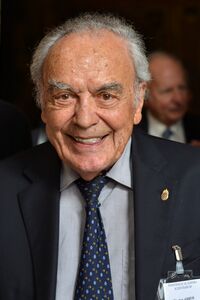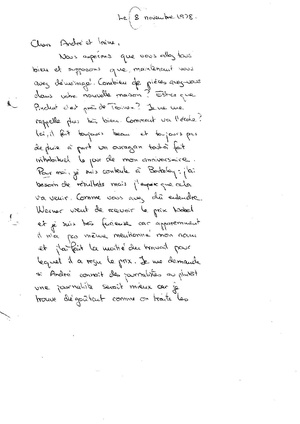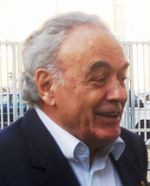ڤرنر أربر
ڤرنر أربر Werner Arber | |
|---|---|
 ڤرنر أربر في 2018 | |
| وُلِدَ | 3 يونيو 1929 گرينيشن، سويسرا |
| الجنسية | سويسرا |
| المدرسة الأم | Old Cantonal School Aarau ETH Zurich |
| عـُرِف بـ | إندونيوكلياز الاقتطاع |
| الأنجال | سيلڤيا آربر |
| الجوائز | جائزة نوبل في الفسيولوجيا أو الطب، 1978 |
| السيرة العلمية | |
| المجالات | علم الأحياء الدقيقة |
| الهيئات | جامعة جنيڤ، جامعة بازل، جامعة جنوب كاليفورنيا |
فرنر أربر (و. 3 يونيو 1929 في گرينشن)، هو عالم أحياء وعالم جينيات سويسري. حصل على جائزة نوبل في الطب عام 1978. مع الباحثَين الأمريكيين هاملتون سميث و دانيال ناثانز, تقاسم ڤرنر آربر جائزة نوبل في الفسيولوجيا أو الطب لعام 1978، لاكتشاف إندونيوكلياز الاقتطاع. عملهم أدى إلى تطور تقنية الدنا المؤشب.
حياته
درس أربر بين عامي 1949 و1953 الكيمياء والفيزياء في المدرسة القديمة في كانتون آرو، زيورخ وتخرج في جنيف عام 1958. بعد عمله كباحث في جامعة جنوب كاليفورنيا، لوس أنجلس عاد مرة أخرى إلى جامعة جنيف من عام 1959 حتى عام 1970.
Late in 1953, he took an assistantship for electron microscopy at the University of Geneva, in time left the electron microscope, went on to research bacteriophages and write his dissertation on defective lambda prophage mutants. In his Nobel Autobiography, he writes:
In the summer of 1956, we learned about experiments made by Larry Morse and Esther and Joshua Lederberg on the lambda-mediated transduction (gene transfer from one bacterial strain to another by a bacteriophage serving as vector) of bacterial determinants for galactose fermentation. Since these investigators had encountered defective lysogenic strains among their transductants, we felt that such strains should be included in the collection of lambda prophage mutants under study in our laboratory. Very rapidly, thanks to the stimulating help by Jean Weigle and Grete Kellenberger, this turned out to be extremely fruitful. ... This was the end of my career as an electron microscopist and in chosing [ك] genetic and physiological approaches I became a molecular geneticist.
Arber received his doctorate in 1958 from the University of Geneva. He then worked at the University of Southern California in phage genetics with Gio ("Joe") Bertani starting in the summer of 1958.[1] Late in 1959 he accepted an offer to return to Geneva at the beginning of 1960, but only after spending "several very fruitful weeks"[2] at each of the laboratories of Gunther Stent (University of California, Berkeley), Joshua Lederberg and Esther Lederberg[3] (Stanford University) and Salvador Luria (Massachusetts Institute of Technology). Arber notes that it was in 1963, while he was a researcher in Stent's Berkeley lab, when experiments produced the first evidence that modification in E. coli B and K is brought about by nucleotide methylation.[4]
Back at the University of Geneva, Arber worked in a laboratory in the basement of the Physics Institute, where he carried out productive research and hosted "a number of first class graduate students, postdoctoral fellows and senior scientists." including Daisy Roulland Dussoix,[2] whose work helped him to later obtain the Nobel Prize.[5] In 1965, the University of Geneva promoted him to Extraordinary Professor for Molecular Genetics. In 1971, after spending a year as a visiting Miller Professor in the Department of Molecular Biology at Berkeley, Arber moved to the University of Basel. In Basel, he was one of the first persons to work in the newly constructed Biozentrum, which housed the departments of biophysics, biochemistry, microbiology, structural biology, cell biology and pharmacology and was thus conducive to interdisciplinary research.
On 27 occasions since 1981, Werner Arber has shared his expertise and passion for science with young scientists at the Lindau Nobel Laureate Meetings.[6]
Werner Arber is member of the World Knowledge Dialogue Scientific Board and of the Pontifical Academy of Sciences since 1981. In 1981, Arber became a founding member of the World Cultural Council.[7] He was elected a Fellow of the American Academy of Arts and Sciences in 1984.[8] Pope Benedict XVI appointed him as President of the Pontifical Academy of Sciences in January 2011, making him the first Protestant to hold the position.[9] In 2017, Arber retired as President of the Pontifical Academy of Sciences and was replaced by German scientist Joachim von Braun.[10]
الحياة الشخصية
Arber is married and has two daughters, including Silvia Arber.
Arber is a Christian and theistic evolutionist, stating "The most primitive cells may require at least several hundred different specific biological macromolecules. How such already quite complex structures may have come together, remains a mystery to me. The possibility of the existence of a Creator, of God, represents to me a satisfactory solution to this problem."[11] In addition, he has affirmed: "I know that the concept of God helped me to master many questions in life; it guides me in critical situations, and I see it confirmed in many deep insights into the beauty of the functioning of the world."[12]
المراجع
- ^ "Arber, Werner". Cartage.org.lb. 1929-06-03. Retrieved 2012-09-09.
- ^ أ ب "Werner Arber - Autobiography". Nobelprize.org. 1929-06-03. Retrieved 2012-09-09.
- ^ Again from Arber's Nobel Autobiography: "One of the first experiments after my return to Geneva was to render E. coli B and its radiation resistant strain B/r sensitive to phage lambda. The first step to accomplish this was easy thanks to a hint received from Esther Lederberg to look for cotransduction of the Ma1+ and lambdaS characters."
- ^ "Werner Arber - Biographical". nobelprize.org.
- ^ M. Zimmer Lederberg, Esther. "Esther M. Zimmer Lederberg: Gender Discrimination: Daisy Roulland Dussoix". www.estherlederberg.com. Retrieved 2017-03-10.
- ^ "Werner Arber - Meetings". www.mediatheque.lindau-nobel.org. Retrieved 2017-12-21.
- ^ "About Us". World Cultural Council. Retrieved November 8, 2016.
- ^ "Book of Members, 1780-2010: Chapter A" (PDF). American Academy of Arts and Sciences. Retrieved 22 April 2011.
- ^ "Vatican appoints Protestant as scientific body's head - INQUIRER.net, Philippine News for Filipinos". Newsinfo.inquirer.net. 2011-01-16. Retrieved 2012-09-09.
- ^ "New head of Pontifical Academy of Science a natural Francis choice". 2017-06-23.
- ^ Arber, W. 1992. The Existence of a Creator Represents a Satisfactory Solution. In Margenau, H. and R. A. Varghese (eds.), Cosmos, Bios, Theos: Scientists Reflect on Science, God, and the Origins of the Universe, Life, and Homo sapiens. La Salle, IL: Open Court, p. 141-142.
- ^ Arber, W. 1992. The Existence of a Creator Represents a Satisfactory Solution. In Margenau, H. and R. A. Varghese (eds.), Cosmos, Bios, Theos: Scientists Reflect on Science, God, and the Origins of the Universe, Life, and Homo sapiens. La Salle, IL: Open Court, p. 143.
للاستزادة
- Konforti, B (Feb 2000). "History. The servant with the scissors". Nature Structural Biology. 7 (2): 99–100. doi:10.1038/72469. ISSN 1072-8368. PMID 10655607. S2CID 43386756.
- Raju, Tn (Oct 1999). "The Nobel chronicles. 1978: Werner Arber (b 1929); Hamilton O Smith (b 1931); Daniel Nathans (b 1928)". Lancet. 354 (9189): 1567. doi:10.1016/S0140-6736(05)76606-X. ISSN 0140-6736. PMID 10551539. S2CID 53257399.
- Shampo, Ma; Kyle, Ra (Oct 1995). "Werner Arber--Nobel laureate". Mayo Clinic Proceedings. 70 (10): 945. doi:10.4065/70.10.sv. ISSN 0025-6196. PMID 7564545.
- Kroon, Am (Feb 1979). "The Nobel Prize for Medicine and Physiology in 1978 (Werner Arber, Daniel Nathans, Hamilton Smith)". Nederlands Tijdschrift voor Geneeskunde. 123 (5): 153–6. ISSN 0028-2162. PMID 368662.
- Piekarowicz, A (1979). "Werner Arber, Daniel Nathans and Hamilton Smith. Nobel prizes for the studies on DNA restriction enzymes". Postepy Biochemii. 25 (2): 251–3. ISSN 0032-5422. PMID 388391.
- Berg, K (Dec 1978). "The Nobel prize in physiology and medicine 1978. Nobel prize to a controversial research field". Tidsskrift for den Norske Laegeforening. 98 (34–36): 1741–2. ISSN 0029-2001. PMID 725894.
- Desiderio, S; Boyer, S (Nov 1978). "Arber, Smith and Nathans: Nobel Laureates in medicine and physiology, 1978". The Johns Hopkins Medical Journal. 143 (5): ix–x. ISSN 0021-7263. PMID 364154.
- "The Nobel prizewinners 1978: medicine. From modest beginnings...". Nature. 275 (5682): 689–90. Oct 1978. Bibcode:1978Natur.275..684.. doi:10.1038/275684a0. ISSN 0028-0836. PMID 360075. S2CID 4221192.
- Peterson, Lr; Gerding, Dn (Aug 1978). "Protein binding and antibiotic concentrations". Lancet. 2 (8085): 376. doi:10.1016/S0140-6736(78)92977-X. ISSN 0140-6736. PMID 79742. S2CID 26011122.
- Petterson, R (1978). "Nobel prize laureates in physiology and medicine". Duodecim; Laaketieteellinen Aikakauskirja. 94 (23): 1466–9. ISSN 0012-7183. PMID 729493.
وصلات خارجية
- ڤرنر أربر on Nobelprize.org

- Official Biography from the Pontifical Academy of Sciences
- Free to View Video Interview with Werner Arber provided by the Vega Science Trust.
| ألقاب الكنيسة الكاثوليكية | ||
|---|---|---|
| سبقه Nicola Cabibbo |
President of the Pontifical Academy of Sciences 15 January 2011 – 2017 |
تبعه Joachim von Braun |
قالب:1978 Nobel Prize winners قالب:Founding members of the World Cultural Council
خطأ لوا في وحدة:Authority_control على السطر 278: attempt to call field '_showMessage' (a nil value).
- Short description is different from Wikidata
- Pages using infobox scientist with unknown parameters
- Nobelprize template using Wikidata property P8024
- مواليد 1929
- أشخاص أحياء
- People from Aarau District
- علماء ميكروبات سويسريون
- أعضاء أكاديمية العلوم الوطنية الأمريكية
- علماء أحياء سويسريون
- Phage workers
- حائزو جائزة نوبل في الطب
- خريجو جامعة جنيف
- طاقم تدريس جامعة جنوب كاليفورنيا
- كلية جامعة جنيف
- سويسريون فائزون بجائزة نوبل
- أعضاء أكاديمية العلوم الپاپوية
- خريجو المعهد الاتحادي للتكنولوجيا بزيورخ
- Swiss Protestants
- Presidents of the Pontifical Academy of Sciences
- Members of the European Molecular Biology Organization
- ETH Zurich alumni
- Recipients of the Great Cross of the National Order of Scientific Merit (Brazil)
- زملاء الأكاديمية الأمريكية للفنون والعلوم
- Biozentrum University of Basel
- Theistic evolutionists
- Fellows of the American Academy of Microbiology

